
Volume XII, Issue XX
Phantasies
By George MacDonald, Chapter 14
Your gallery
Ha we pass'd through, not without much content
In many singularities; but we saw not
That which my daughter came to look upon,
The state of her mother."
~ from William Shakespeare's Winter's Tale.
It seemed to me strange, that all this time I had heard no music in the fairy palace. I was convinced there must be music in it, but that my sense was as yet too gross to receive the influence of those mysterious motions that beget sound. Sometimes I felt sure, from the way the few figures of which I got such transitory glimpses passed me, or glided into vacancy before me, that they were moving to the law of music; and, in fact, several times I fancied for a moment that I heard a few wondrous tones coming I knew not whence. But they did not last long enough to convince me that I had heard them with the bodily sense. Such as they were, however, they took strange liberties with me, causing me to burst suddenly into tears, of which there was no presence to make me ashamed, or casting me into a kind of trance of speechless delight, which, passing as suddenly, left me faint and longing for more.
Now, on an evening, before I had been a week in the palace, I was wandering through one lighted arcade and corridor after another. At length I arrived, through a door that closed behind me, in another vast hall of the palace. It was filled with a subdued crimson light; by which I saw that slender pillars of black, built close to walls of white marble, rose to a great height, and then, dividing into innumerable divergent arches, supported a roof, like the walls, of white marble, upon which the arches intersected intricately, forming a fretting of black upon the white, like the network of a skeleton-leaf. The floor was black.
Between several pairs of the pillars upon every side, the place of the wall behind was occupied by a crimson curtain of thick silk, hanging in heavy and rich folds. Behind each of these curtains burned a powerful light, and these were the sources of the glow that filled the hall. A peculiar delicious odour pervaded the place. As soon as I entered, the old inspiration seemed to return to me, for I felt a strong impulse to sing; or rather, it seemed as if some one else was singing a song in my soul, which wanted to come forth at my lips, imbodied in my breath. But I kept silence; and feeling somewhat overcome by the red light and the perfume, as well as by the emotion within me, and seeing at one end of the hall a great crimson chair, more like a throne than a chair, beside a table of white marble, I went to it, and, throwing myself in it, gave myself up to a succession of images of bewildering beauty, which passed before my inward eye, in a long and occasionally crowded train. Here I sat for hours, I suppose; till, returning somewhat to myself, I saw that the red light had paled away, and felt a cool gentle breath gliding over my forehead. I rose and left the hall with unsteady steps, finding my way with some difficulty to my own chamber, and faintly remembering, as I went, that only in the marble cave, before I found the sleeping statue, had I ever had a similar experience.
After this, I repaired every morning to the same hall; where I sometimes sat in the chair and dreamed deliciously, and sometimes walked up and down over the black floor. Sometimes I acted within myself a whole drama, during one of these perambulations; sometimes walked deliberately through the whole epic of a tale; sometimes ventured to sing a song, though with a shrinking fear of I knew not what. I was astonished at the beauty of my own voice as it rang through the place, or rather crept undulating, like a serpent of sound, along the walls and roof of this superb music-hall. Entrancing verses arose within me as of their own accord, chanting themselves to their own melodies, and requiring no addition of music to satisfy the inward sense. But, ever in the pauses of these, when the singing mood was upon me, I seemed to hear something like the distant sound of multitudes of dancers, and felt as if it was the unheard music, moving their rhythmic motion, that within me blossomed in verse and song. I felt, too, that could I but see the dance, I should, from the harmony of complicated movements, not of the dancers in relation to each other merely, but of each dancer individually in the manifested plastic power that moved the consenting harmonious form, understand the whole of the music on the billows of which they floated and swung.
At length, one night, suddenly, when this feeling of dancing came upon me, I bethought me of lifting one of the crimson curtains, and looking if, perchance, behind it there might not be hid some other mystery, which might at least remove a step further the bewilderment of the present one. Nor was I altogether disappointed. I walked to one of the magnificent draperies, lifted a corner, and peeped in. There, burned a great, crimson, globe-shaped light, high in the cubical centre of another hall, which might be larger or less than that in which I stood, for its dimensions were not easily perceived, seeing that floor and roof and walls were entirely of black marble.
The roof was supported by the same arrangement of pillars radiating in arches, as that of the first hall; only, here, the pillars and arches were of dark red. But what absorbed my delighted gaze, was an innumerable assembly of white marble statues, of every form, and in multitudinous posture, filling the hall throughout. These stood, in the ruddy glow of the great lamp, upon pedestals of jet black. Around the lamp shone in golden letters, plainly legible from where I stood, the two words--
TOUCH NOT!
There was in all this, however, no solution to the sound of dancing; and now I was aware that the influence on my mind had ceased. I did not go in that evening, for I was weary and faint, but I hoarded up the expectation of entering, as of a great coming joy.
Next night I walked, as on the preceding, through the hall. My mind was filled with pictures and songs, and therewith so much absorbed, that I did not for some time think of looking within the curtain I had last night lifted. When the thought of doing so occurred to me first, I happened to be within a few yards of it. I became conscious, at the same moment, that the sound of dancing had been for some time in my ears. I approached the curtain quickly, and, lifting it, entered the black hall. Everything was still as death. I should have concluded that the sound must have proceeded from some other more distant quarter, which conclusion its faintness would, in ordinary circumstances, have necessitated from the first; but there was a something about the statues that caused me still to remain in doubt. As I said, each stood perfectly still upon its black pedestal: but there was about every one a certain air, not of motion, but as if it had just ceased from movement; as if the rest were not altogether of the marbly stillness of thousands of years. It was as if the peculiar atmosphere of each had yet a kind of invisible tremulousness; as if its agitated wavelets had not yet subsided into a perfect calm. I had the suspicion that they had anticipated my appearance, and had sprung, each, from the living joy of the dance, to the death-silence and blackness of its isolated pedestal, just before I entered. I walked across the central hall to the curtain opposite the one I had lifted, and, entering there, found all the appearances similar; only that the statues were different, and differently grouped. Neither did they produce on my mind that impression--of motion just expired, which I had experienced from the others. I found that behind every one of the crimson curtains was a similar hall, similarly lighted, and similarly occupied.
The next night, I did not allow my thoughts to be absorbed as before with inward images, but crept stealthily along to the furthest curtain in the hall, from behind which, likewise, I had formerly seemed to hear the sound of dancing. I drew aside its edge as suddenly as I could, and, looking in, saw that the utmost stillness pervaded the vast place. I walked in, and passed through it to the other end.
There I found that it communicated with a circular corridor, divided from it only by two rows of red columns. This corridor, which was black, with red niches holding statues, ran entirely about the statue-halls, forming a communication between the further ends of them all; further, that is, as regards the central hall of white whence they all diverged like radii, finding their circumference in the corridor.
Round this corridor I now went, entering all the halls, of which there were twelve, and finding them all similarly constructed, but filled with quite various statues, of what seemed both ancient and modern sculpture. After I had simply walked through them, I found myself sufficiently tired to long for rest, and went to my own room.
In the night I dreamed that, walking close by one of the curtains, I was suddenly seized with the desire to enter, and darted in. This time I was too quick for them. All the statues were in motion, statues no longer, but men and women--all shapes of beauty that ever sprang from the brain of the sculptor, mingled in the convolutions of a complicated dance. Passing through them to the further end, I almost started from my sleep on beholding, not taking part in the dance with the others, nor seemingly endued with life like them, but standing in marble coldness and rigidity upon a black pedestal in the extreme left corner--my lady of the cave; the marble beauty who sprang from her tomb or her cradle at the call of my songs. While I gazed in speechless astonishment and admiration, a dark shadow, descending from above like the curtain of a stage, gradually hid her entirely from my view. I felt with a shudder that this shadow was perchance my missing demon, whom I had not seen for days. I awoke with a stifled cry.
Of course, the next evening I began my journey through the halls (for I knew not to which my dream had carried me), in the hope of proving the dream to be a true one, by discovering my marble beauty upon her black pedestal. At length, on reaching the tenth hall, I thought I recognised some of the forms I had seen dancing in my dream; and to my bewilderment, when I arrived at the extreme corner on the left, there stood, the only one I had yet seen, a vacant pedestal. It was exactly in the position occupied, in my dream, by the pedestal on which the white lady stood. Hope beat violently in my heart.
Now," said I to myself, "if yet another part of the dream would but come true, and I should succeed in surprising these forms in their nightly dance; it might be the rest would follow, and I should see on the pedestal my marble queen. Then surely if my songs sufficed to give her life before, when she lay in the bonds of alabaster, much more would they be sufficient then to give her volition and motion, when she alone of assembled crowds of marble forms, would be standing rigid and cold."
But the difficulty was, to surprise the dancers. I had found that a premeditated attempt at surprise, though executed with the utmost care and rapidity, was of no avail. And, in my dream, it was effected by a sudden thought suddenly executed. I saw, therefore, that there was no plan of operation offering any probability of success, but this: to allow my mind to be occupied with other thoughts, as I wandered around the great centre-hall; and so wait till the impulse to enter one of the others should happen to arise in me just at the moment when I was close to one of the crimson curtains. For I hoped that if I entered any one of the twelve halls at the right moment, that would as it were give me the right of entrance to all the others, seeing they all had communication behind. I would not diminish the hope of the right chance, by supposing it necessary that a desire to enter should awake within me, precisely when I was close to the curtains of the tenth hall.
At first the impulses to see recurred so continually, in spite of the crowded imagery that kept passing through my mind, that they formed too nearly a continuous chain, for the hope that any one of them would succeed as a surprise. But as I persisted in banishing them, they recurred less and less often; and after two or three, at considerable intervals, had come when the spot where I happened to be was unsuitable, the hope strengthened, that soon one might arise just at the right moment; namely, when, in walking round the hall, I should be close to one of the curtains.
At length the right moment and the impulse coincided. I darted into the ninth hall. It was full of the most exquisite moving forms. The whole space wavered and swam with the involutions of an intricate dance. It seemed to break suddenly as I entered, and all made one or two bounds towards their pedestals; but, apparently on finding that they were thoroughly overtaken, they returned to their employment (for it seemed with them earnest enough to be called such) without further heeding me. Somewhat impeded by the floating crowd, I made what haste I could towards the bottom of the hall; whence, entering the corridor, I turned towards the tenth. I soon arrived at the corner I wanted to reach, for the corridor was comparatively empty; but, although the dancers here, after a little confusion, altogether disregarded my presence, I was dismayed at beholding, even yet, a vacant pedestal. But I had a conviction that she was near me. And as I looked at the pedestal, I thought I saw upon it, vaguely revealed as if through overlapping folds of drapery, the indistinct outlines of white feet. Yet there was no sign of drapery or concealing shadow whatever. But I remembered the descending shadow in my dream. And I hoped still in the power of my songs; thinking that what could dispel alabaster, might likewise be capable of dispelling what concealed my beauty now, even if it were the demon whose darkness had overshadowed all my life.
(to be continued)
A Case for Vision II
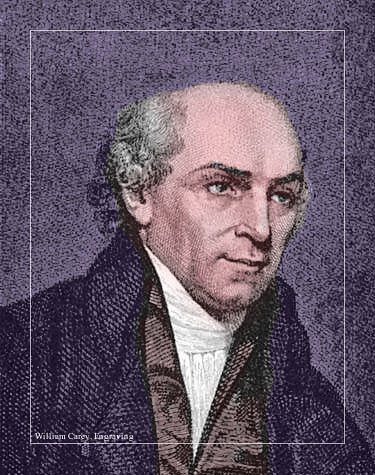
William Carey.
Sing, O barren, thou that didst not bear; break forth into singing, and cry aloud, thou that didst not travail with child: for more are the children of the desolate than the children of the married wife, saith the Lord.
Enlarge the place of thy tent, and let them stretch forth the curtains of thine habitations: spare not, lengthen thy cords, and strengthen thy stakes;
For thou shalt break forth on the right hand and on the left; and thy seed shall inherit the Gentiles, and make the desolate cities to be inhabited.
Fear not; for thou shalt not be ashamed: neither be thou confounded; for thou shalt not be put to shame: for thou shalt forget the shame of thy youth, and shalt not remember the reproach of thy widowhood any more.
For thy Maker is thine husband; the Lord of hosts is his name; and thy Redeemer the Holy One of Israel; The God of the whole earth shall he be called." -- Isaiah 54:1-5
William Carey
For three hundred years following the Reformation, many church leaders neglected the command of Christ to reach the nations. Towards the end of the Eighteenth Century, a newly ordained Baptist leader in England spoke to challenge this misapplication of the doctrine of election. "Young man, sit down! You are an enthusiast. When God pleases to convert the heathen, he'll do it without consulting you or me," said an older minister. The young man's name was William Carey. He was a cobbler by trade, but his calling would take him far beyond the walls of his little cobbler's shop. Carey's vision, you see, was as wide as the map of the world that he hung on his shop's wall. Gathering some like-minded friends, he began to pray for the fulfillment of his vision.
Carey admired the work of the Moravians [click to read], who at one point were one of the foremost sending congregations, planting churches around the world. They even founded churches among America's Cherokee Nation. Dismayed by his own denomination's lack of zeal for such work, he penned An Enquiry Into The Obligations Of Christians To Use Means For The Conversion Of The Heathens. Seeing the Great Commission as applying to the church of his day, he said: "Multitudes sit at ease and give themselves no concern about the far greater part of their fellow sinners, who to this day, are lost in ignorance and idolatry."
In 1792, Carey organized a missionary society and called for his fellow believers to: "Expect great things from God; attempt great things for God!" Few men today would have the patience and tenacity of Carey who said: "I can plod, I can persevere to any definite pursuit." Carey offered to become the first missionary of his society to the great subcontinent of India, offering to go if his friends back home would "hold the ropes." After a fourteen month journey and many personal tragedies, Carey labored on for seven years before he saw his first convert, Krishna Pal. Two months later he published his first Bengali New Testament. He and his colleagues would go on to publish translations of the entire Bible in Bengali, Oriya, Marathi, Hindi, Assamese, and Sanskrit, as well as hundreds of lesser used dialects.
Carey was instrumental in significant social reform in India. His work and advocacy resulted in the abolition of infanticide, widow burning (sati), and assisted suicide. Thus did a man's love for his Saviour result in the affirmation of Imago Dei in a whole new part of the world. When William Carey died, he had served the people of India for 41 years!
When Isaiah wrote the book that bears his name, Israel had forgotten the G-d given mission to be a light to the nations. Losing sight of this important purpose, the people sank into idolatry and pleasure-seeking. Every generation faces the very real danger of missing the great calling. Ours is no exception. Pastor Bruce Hankee related the story of Carey to his congregation, challenging us to program our lives for G-d's purpose through an understanding of Isaiah 54:1-5. He challenged us to enlarge our capacity for G-d's purpose, as Carey did. Ephesians 3:19 exhorts us: "And to know the love of Christ, which passeth knowledge, that ye might be filled with all the fulness of God." Indeed this is a great reason to expand our tent, that we might contain more of the love of G-d for our fellows! In lengthening our cords, we are expanding our influence. Just as a cobbler in the middle of England became a major pioneer in world missions, we too can have a greater influence if we will persevere in the pursuit of a great vision.
Counterpoint to Coruscant
Two Arguments Set in Stone for a Low Profile Capital
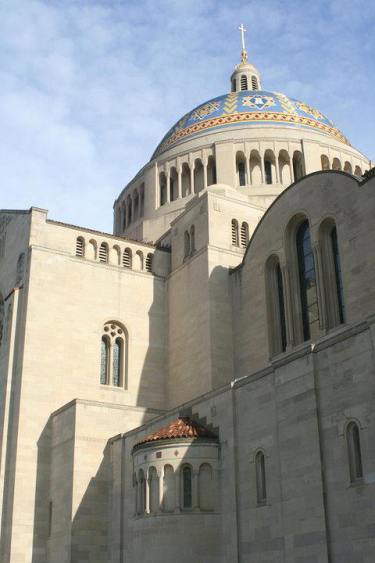
The Basilica of the National Shrine of the Immaculate Conception... Photo by Kristina Elaine Greer.
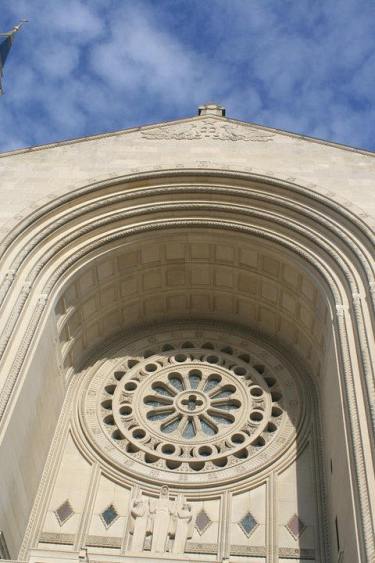
...is a fine example of Byzantine-Romanesque architecture. Photo by Kristina Elaine Greer.
The Shrine and the Cathedral
One unique distinctive of the city of Washington is its relatively low profile. The capital of the greatest nation on the face of the Earth is a city without skyscrapers. New York and Chicago, the great engines of finance and commerce, thrust their architectural presence into the sky while the nation's capital's relatively modest scale defers to iconic buildings that speak of the history and aspirations of her people.
It is widely believed that the legislation controlling building heights was put in place to make sure the Washington Monument would remain the tallest building in the city. The actual legislation has to do with the height of buildings in relation to the width of the streets they occupy.
The Height of Buildings Act of 1910 restricts all buildings in Washington D.C. to being no higher than the width of the adjacent street plus 20 feet. A building on a street that is 130 feet wide can only be 150 feet tall. To be taller than the 555 foot Washington Monument without violating this law, a building would need to be on a street that is over 535 feet wide.
The result is a city who's outlying neighborhoods open to vistas of splendid shrines and cathedrals. Her Northern neighborhoods are crowned by two architectural treasures: the National Cathedral and the the Basilica of the National Shrine of the Immaculate Conception.
Pierre Charles L'Enfant's original vision for the city, based on the palace and garden of Versailles, lends itself well to a garden city punctuated by such fine monuments. The gothic National cathedral brings to mind the great churches of Europe.

The McMillan Plan.
Pierre Charles L'Enfant's "Plan of the Federal City,” drawn in 1792,set aside a prominent site for a "great church for national purposes." Today the National Portrait Gallery stands in that place. It was not until 1891 that a meeting was held to renew plans for a National Cathedral. L’Enfant’s grand plan gave way to the Nineteenth Century growth of the city. Train tracks ran across what would become the National Mall.
At the beginning of the Twentieth Century, The United States Senate Park Commission was formed. Known as the McMillan Commission, it was named for its chairman, Senator James McMillan of Michigan. Some of the greatest American architects, landscape architects, and urban planners of the day served on the McMillan Commission, including Daniel Burnham, Frederick Law Olmsted, Jr., Charles F. McKim, and Augustus Saint-Gaudens. The Washington DC that we know today, with it’s inspiring vistas, cherry trees and reflecting pools is largely the product of this commission.
In 1902 the commission’s plan was published. Building on the work of L’Enfant, and inspired by the Cities Beautiful Movement, a grand but beautifully scaled Washington began to take shape. In her Northern reaches, plans for two beautiful houses of worship were also taking shape.
Frederick Bodley, known for his fine church designs in England, led the team designing the Cathedral Church of Saint Peter and Saint Paul for the Episcopal Diocese of Washington. [1.] Construction began in 1907. After World War I, Philip Hubert Frohman, an American architect, took over the supervision of the work. Construction of the National Cathedral went on for most of the Twentieth Century. As good stonemasons became harder to find, work was speeded up. Then a program to train stone masons was established on the Cathedral grounds. The Gothic cathedral features beautiful bas relief sculptures of the Creation and a gargoyle that resembles French President Charles DeGaulle! A statue of Darth Vader [2.] is up there as well, sculpted by Jay Hall Carpenter and Patrick J. Plunkett. The building was completed in 1990.
Today the cathedral is a prominent feature of the Northwest Quadrant of the city.
Bishop Thomas Joseph Shahan, the fourth rector of the Catholic University of America envisioned the construction of a national shrine to commemorate the Immaculate Conception in the country's capital. [3.] He took his appeal to Pope Pius X on August 15, 1913. The Pope was excited by Shahan’s vision and Catholic University donated land on its campus in the Northeast Quadrant of the city.
Architects Maginnis and Walsh of Boston first proposed a gothic building as well, but Bishop Shahan wanted the shrine to be bold, glorious and unique. A Byzantine-Romanesque design was chosen. The archbishop of Baltimore, Cardinal James Gibbons, blessed the foundation stone on September 23, 1920.
The Great Depression halted construction, as did the Second World War. In 1953 construction resumed and continued through the Twentieth Century. There are still mosaics remaining to be completed in the great dome, but the building is essentially complete. The Basilica of the National Shrine of the Immaculate Conception rises above the grey buildings of Catholic University as a prominent feature of the cityscape.
Thus two great architectural testimonies of faith hold their place in the profile of our nation’s capital. Neither is supported by federal monies but the presence of both stands as a reminder that: “Behold, the nations are as a drop of a bucket, and are counted as the small dust of the balance: behold, he taketh up the isles as a very little thing.” -- Isaiah 40:15
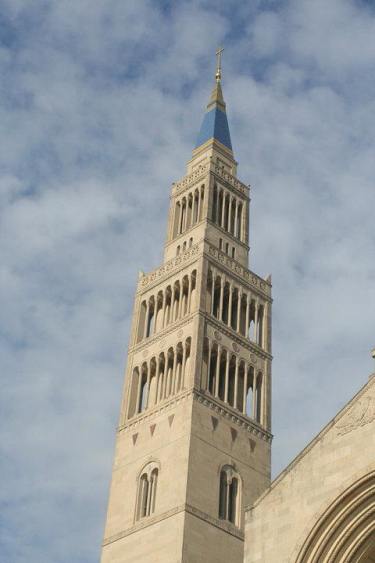
Tower... Photo by Kristina Elaine Greer.

...and tile of the National Shrine. Photo by Kristina Elaine Greer.

The National Cathedral. Photo by Kristina Elaine Greer.

Rose window in the cathedral. Photo by Kristina Elaine Greer.

Flying buttresses of the cathedral. Photo by Kristina Elaine Greer.
The Reckless Engineer
short Story by Bob Kirchman (continued)
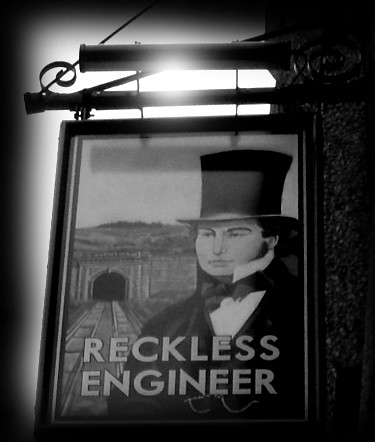
You built the railroads from the West
You built the ships from iron ore and
All of your bridges never rest
But without love they're nothing more”
-- Coast, ‘The Reckless Engineer’
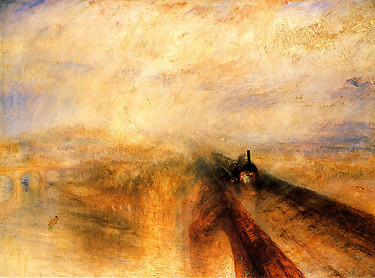
Rain, Steam and Speed - The Great Western Railway, by J. M. W. Turner. 1843
John and Alana (for that is the young couple’s names) arrived early the next morning at the offices of the Zimmerman Organization high in a tower overlooking the Strait. They were ushered into the reception area by a lovely young lady who had a distinct sparkle in her mischievous green eyes. “Hello, I’m Hannah,” she greeted them. “Mr. Zimmerman will be with you momentarily, but would you like some coffee?” “Uh, sure,” the young couple responded as Rupert’s receptionist zipped around the corner of her ample desk, grabbed a tray and dispensed their choices of beverage and placed it on a table by their chairs.
Please excuse my zipping about. My ‘Bionic’ leggings are being retuned today so I’m back in the chair for a bit. If you’d like, we could show you a bit of the research lab before you take the grand tour.” Alana’s eyes grew wide. “I’ve heard many amazing things about the lab. I would LOVE to see it!” She remembered the wonderful story of how Alexander Graham Bell had begun his research with the effort to give sound to the deaf. Here in the remotest part of the world, his legacy continued. “The lady who developed the assistive leggings and I work closely together,” said Hannah. “What is really cool is how they are truly assistive. They do nothing FOR me, but rather provide a little extra steam and steadiness to MY walking. You will see some amazing things happening here… artificial sight for the blind, direct transfer of sound to nerves, and a whole new level of prosthetics.”
We would love to see as much as you are willing to show us,” said John, “We are in no great hurry to venture off into Siberia.”
Good,” because we have three days worth of tour if you’d like it!”
This is what I call the ‘Labyrinth of Exile’” Zimmerman began as they walked through the tower’s endless corridors. “It’s named after a biography of Theodor Herzl, Father of the modern state of Israel, from where many of our brightest researchers hail from.” Indeed the small nation was well represented, as was most of the rest of the world in the serious faces that greeted them over the course of the next three hours. Zimmerman was clearly delighted to introduce every one of them, like the cherished family he considered them to be. “Don’t make the mistake of thinking me any less than the tough old bird you’ve heard me to be. I crack the whip around here!” “Yes Papa, you do,” said a young woman in white coveralls and a hard hat. She had slipped up behind them, placing herself deliberately behind the old man’s back… he feigned displeasure at her looking over his shoulder, but his face betrayed a deep love for the young lady.
Well, I suppose you should meet my GRANDDAUGHTER,” he said somewhat in a feigned disparaging way. “She will be with us tomorrow when we tour the great bridge, but today I wonder if she would be willing to show you our design rooms?”
On the boards were two great designs for covered entrances to the great bridge. If the bridge was spare and functional, the approach covers were anything but. They were drawn in the style of Santiago Calatrava, the great bridge architect. Zimmerman called them “Paddington Station” and “Temple Meade” after the great trainsheds of Nineteenth Century designer Isambard Kingdom Brunel. “We sort of specialize in ‘reckless engineering’ here,” he said. Zimmerman’s granddaughter chimed in: “Calatrava’s genius was that he saw the design disciplines as one and that the wonder of living things could guide you in it. Papa sent me to study under him for a while.”
Calatrava built bridges, buildings, even children’s toys, but his mind was the same in all of these disciplines. Nature, if you were quiet and observed it, was your true teacher.”
(to be continued)
© 2017 The Kirchman Studio, All rights reserved.
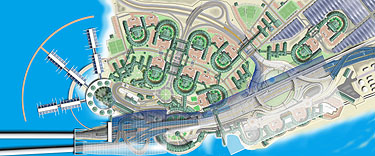
Bering Strait Bridge Complex at Wales. Enlarge [click to view full size]
'Paddington Station' is visible at the bottom of the image... the covered roadway approach to the Bering Strait Bridge. It is named for the famous covered train platforms in London designed by Isambard Kingdom Brunel.
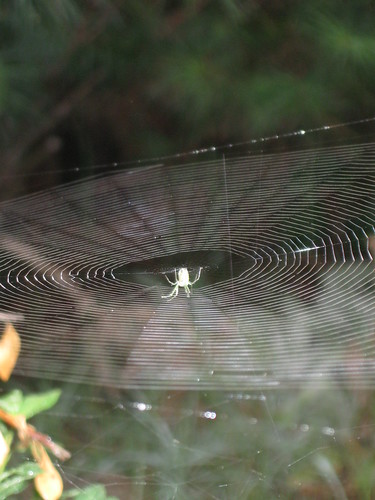
Web. Photo by Bob Kirchman.
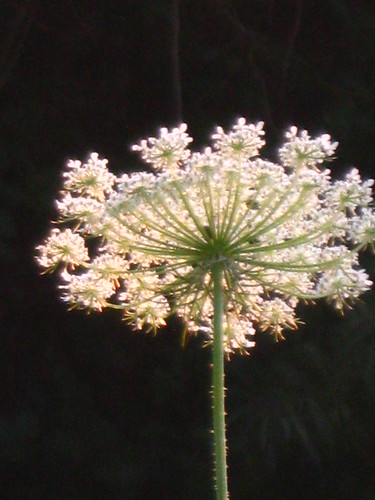
Queen Anne's Lace. Photo by Bob Kirchman.

Bumblebee Flight. Photo by Bob Kirchman.
Michael Goldstone: Ask Isaiah
A Day for Creative Wonder
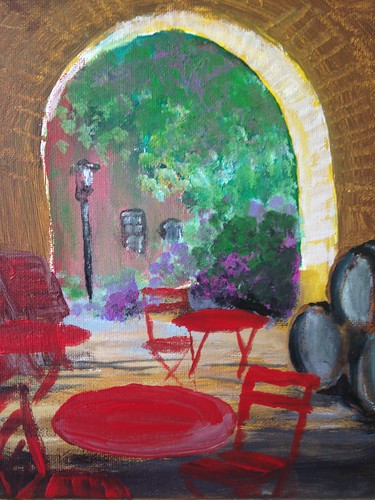
'Red Chairs.' Painting by Bob Kirchman
Painting en Plein Air in Staunton
A Day of Creative Celebration
It was a day that dawned slightly overcast as I headed to town to 'stake out' our painting location. I knew it would be a hot one and I was going to be joined by my student, high school senior Savhanna Herndon and Lilly, a seven-year old who was one of Grace Christian School's best young artists. My concern was that the students have a great experience. The Ox Eye Vineyards tasting room seemed ideal, offering plenty of shade and interesting architecture. We set to work and shared color on our palates as we each tackled our respective painting. I must confess I dispensed with the easel and carried my canvass around as I interacted with the students. I painted what I would consider a good 'demonstration' canvas.
Savhanna chose a rich flower bed on the side of the Ox Eye building and she really started flowing with the project. She'd bought a bunch of new tubes of paint, heavy on what we call the 'Laney Colors,' so named for my last wonderful studio assistant who had pushed us 'brighter' in the renderings. (I was trained in a period which was far more muted and pastel). Savhanna was joying in the profusion of flowers that allowed her to play with happy color. We had arrived early in the morning so the archway area was open. I flitted between Lilly and Savhanna as I observed, and answered questions, but I kept at my own view so as to avoid 'hovering.' It was a good day.
Still, I felt like there wasn't much to my little painting until the staff of Ox Eye set out those wonderful little red tables and chairs! At that point I 'borrowed' some of Savhanna's bright colors and washed the atmospheric perspective. Getting better!, then I quickly rendered the tables and chairs with red, straight out of the tube from Savhanna's palate. Now I was getting somewhere! Suddenly focus and composition intersected in a joyous harmony. I was not expecting it! It was a beautiful day!
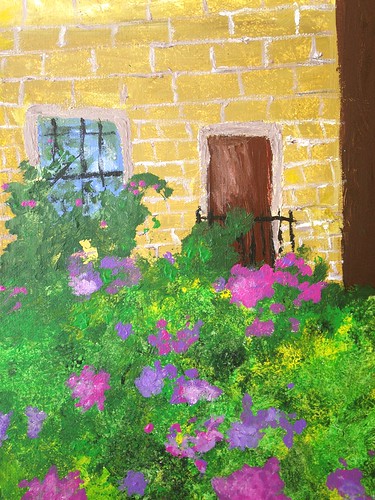
'Flowers at Ox Eye.' Painting by Savhanna Herndon.
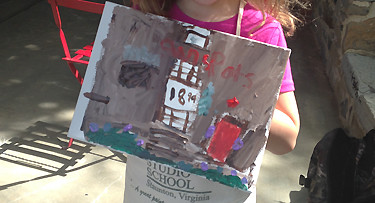
Lilly's Painting of Sunspots across the street.

Savhanna Herndon, after a good morning's work!
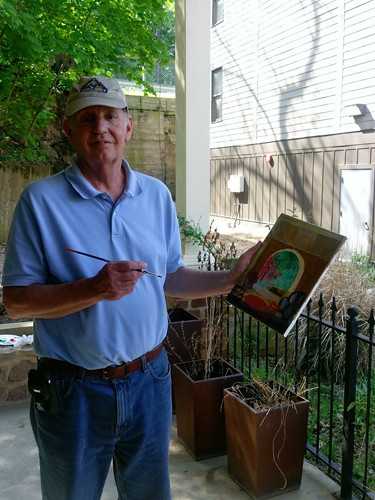
Yes, I painted this standing up. Photo by Susan Kiers
'Over the Bridge'
'Bridge Day' in Staunton, Virginia
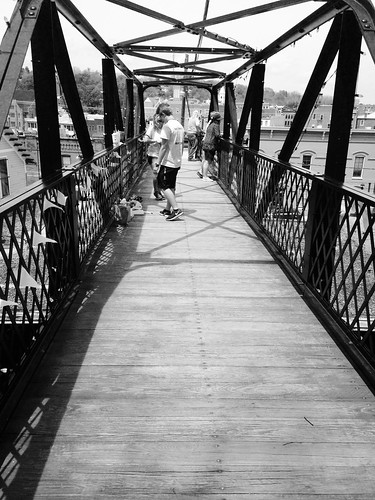
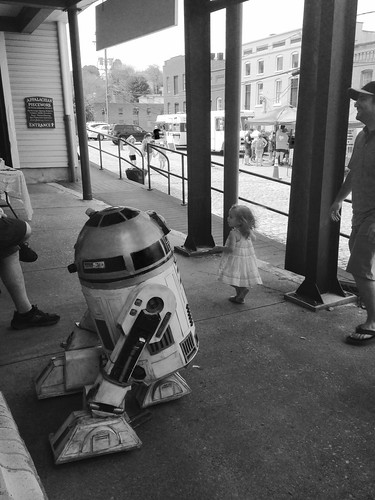
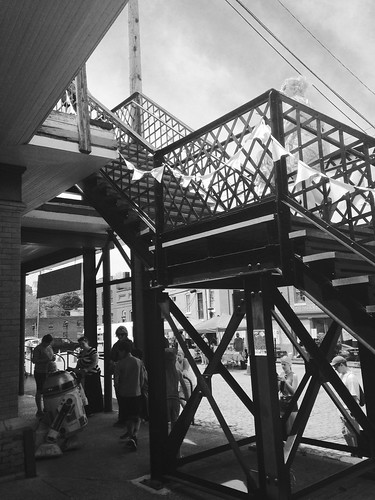
'Bridge Day' was happening as we painted, a celebration of the restoration of the Sears Hill Pedestrian Bridge across the Buckingham Branch Railroad in downtown Staunton. Photos by Bob Kirchman
Off to La La Land
Musical with a Message for Our Time
Director Damien Chazelle unleashes an old-school, tour de force musical, proving that original, Oscar-worthy moviemaking—without R-rated gratuity—is actually still possible in Tinseltown." -- Plugged In
My lovely wife and I finished off the day watching the musical La La Land. It quickly ended up on our: "we need to own this DVD" list. Start with the fact that we both enjoy the old great musicals from Rodgers and Hammerstien and this modern day take off on that style is enjoyable in its own right. But where the old musicals often were fairly light on the story and heavy on the lavish numbers, La La Land had a great story to tell as well. The story is that of Sebastian (Ryan Gosling) and Mia (Emma Stone). He is a struggling keyboard artist and she is an aspiring actor. They meet in an awkward manner and their most decidedly unromantic beginnings are the beginnings of a sweet tale of love, creative aspiration, and collaboration.
It was fascinating to see how movie critics found things about the film to lambaste, such as Sebastian's love of traditional Jazz and his conflicts as he takes up playing in a Fusion band in order to move forward. While real music buffs might find it wanting in substance, the 'short explaination' offered by Sebastian is good enough for most of us. That and Mia's endless frustration in casting calls was actually quite a good build up to a tale about the tensions in a creative life. The fact is, for two creative people who've done Marriage Encounter, the film sparked some wonderful communication. I learned something.
We creatives often get so caught up in that which drives us that we become real jerks... especially with those we love the most. That is painful truth number one in this film as Sebastian, newly fired for not playing the required sets at his restaurant gig, leaves in a huff, smashing into Mia, who will eventually go on to become his greatest encourager. The themes of creative drive, love and encouragement, and sacrifice for another person make this a worthy movie indeed. Sebastian's narcissism created some good 'ouch' moments for me. Real sacrifice, it turns out, is not in the heroic selfless decision so much as in the daily 'dying to self' that makes life with another person rich. Indeed, there is a 'replay' moment near the end of the film that makes this clear.
Life itself is awkward. The film makes that clear, and I think anyone who's really loved and lived, and been the recipient of loving encouragement, will certainly find themselves in this story.
